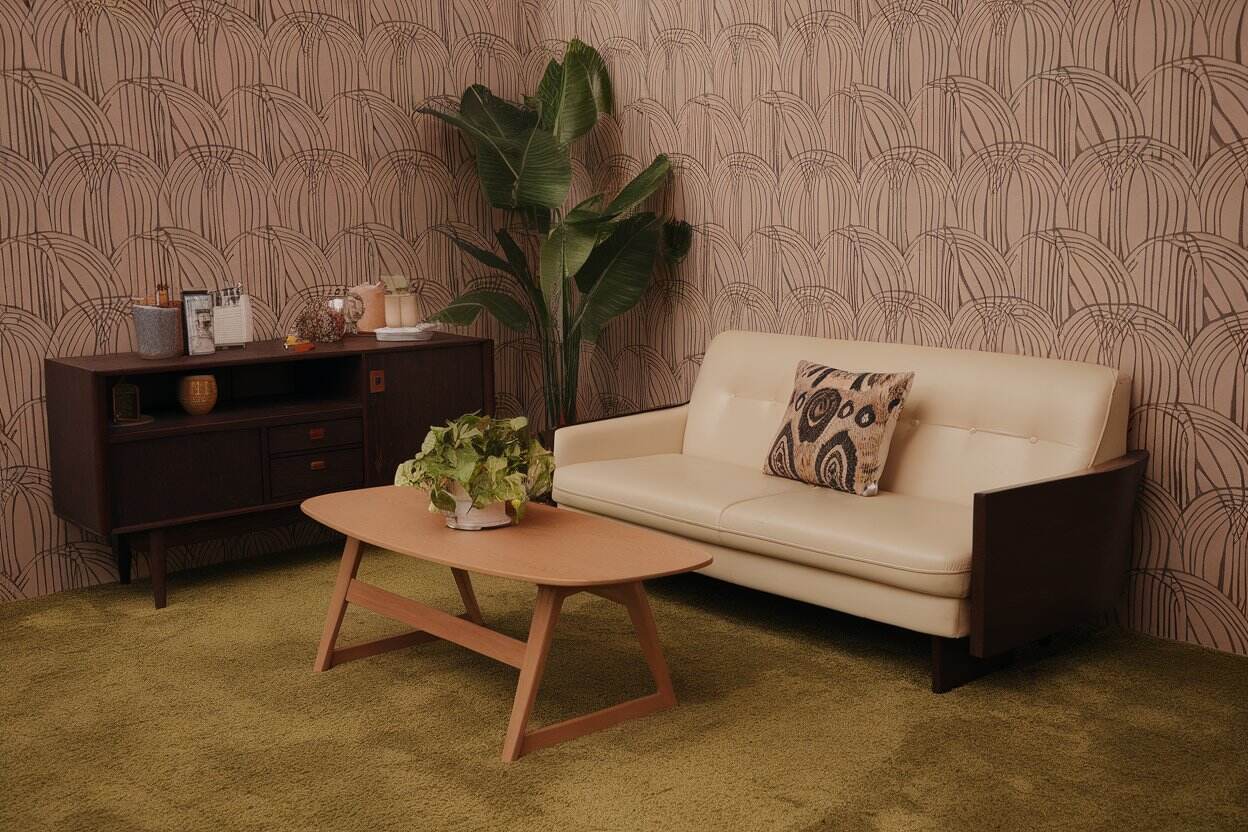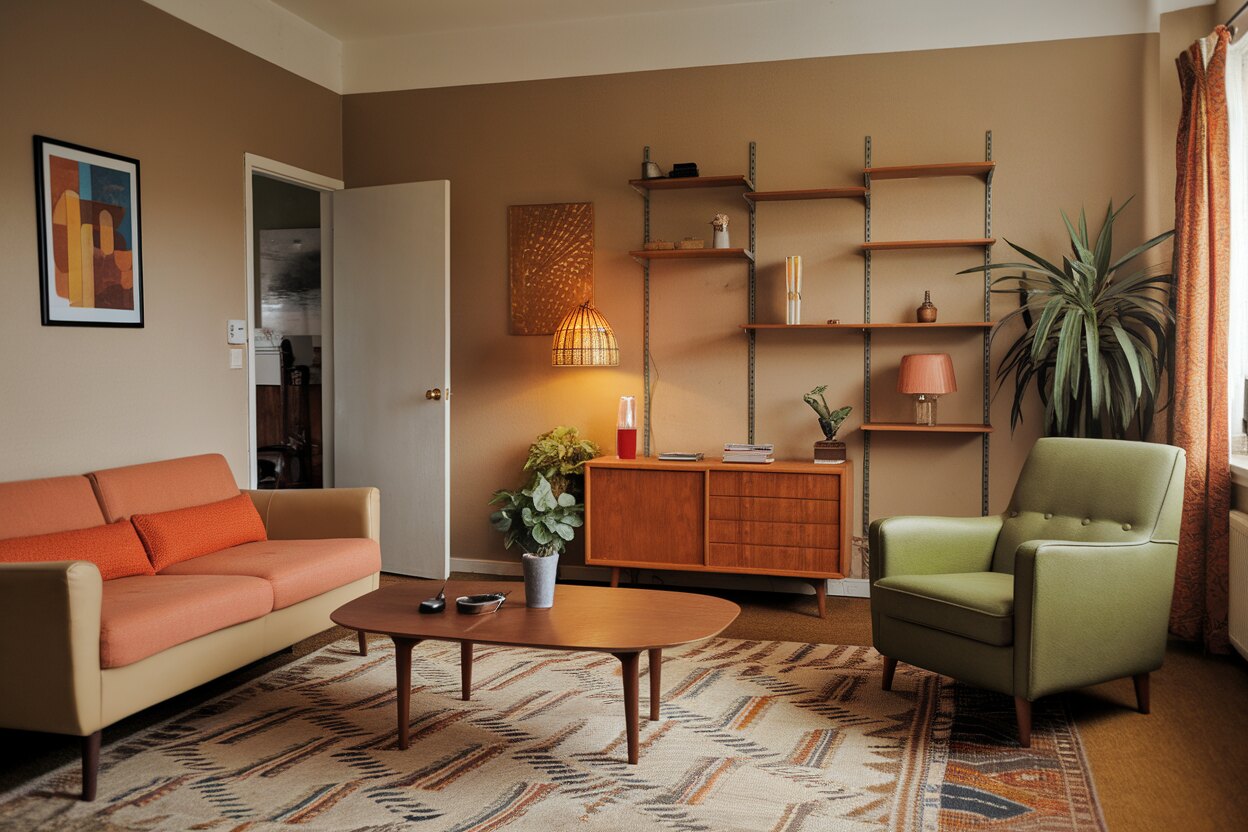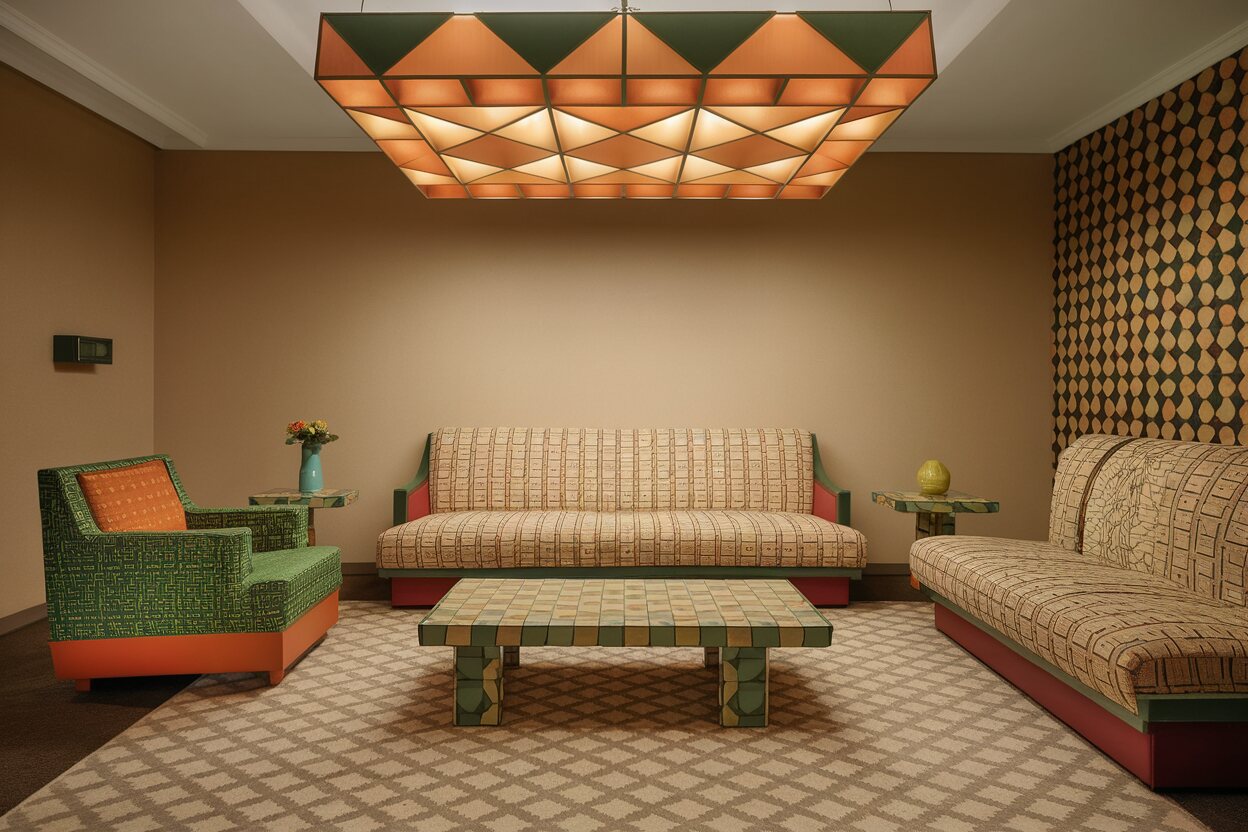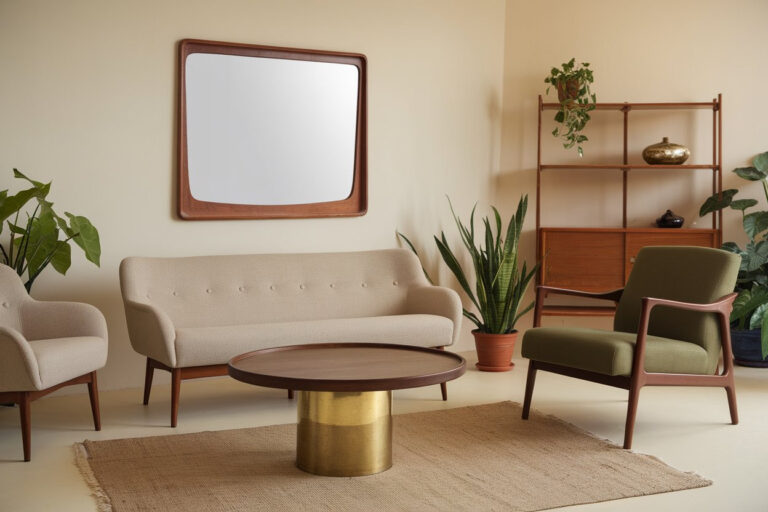In this blog, I will share why ’70s interior design is making a big comeback and how you can incorporate it into your home.
The 70s aesthetic is more than just a trend its a response to modern design fatigue. People are moving away from cold, minimal spaces and embracing warmth, personality, and comfort. Earthy tones, bold patterns, and natural materials create a cozy yet stylish environment that feels inviting and nostalgic.
This revival isn’t about recreating the past exactly. Instead, its about blending retro charm with modern functionality. Whether its a statement piece like a curved sofa or small touches like rattan decor, there are endless ways to bring ’70s vibes into your space.
Defining Features of 70s Interior Design
Iconic Colors
If you love warm, inviting spaces, the ’70s color palette is for you. Think avocado green, mustard yellow, burnt orange, and deep brown shades that instantly make a home feel cozy. These colors were everywhere, from kitchen cabinets to plush sofas.
But the 70s weren’t just about earthy tones. Bold contrasts make the interiors stand out. A deep brown wall might be paired with a bright orange chair. Geometric wallpaper added pops of color against neutral backgrounds. It was all about mixing warmth with vibrancy.
![]()
Key Materials & Textures
Texture played a huge role in 70s design, making rooms feel dynamic and layered. Velvet sofas brought in softness while rattan chairs added an organic touch. If you’re drawn to cozy, lived-in spaces, these materials help create that nostalgic charm.
Walls weren’t just painted; they were wood-paneled or exposed brick. These elements gave homes depth and warmth, making them feel grounded. And for a playful touch? Shag rugs and macrame. Thick carpets underfoot and handcrafted macrame wall hangings added personality and a DIY spirit to interiors.

Must-Have Furniture & Layouts
The ’70s were all about comfort and connection. Low, curved sofas weren’t just stylish they were designed for lounging. Their deep seats and modular shapes make them perfect for stretching out or gathering with friends.
If you want to fully embrace the era, consider a sunken living room. These cozy conversation pits encouraged relaxed, intimate gatherings. They blended seamlessly into open spaces, making homes feel more social.
Furniture had a futuristic edge, too. Cantilever chairs and geometric tables gave rooms a sleek, modern vibe. These pieces werent just functional they made a statement.

Signature Patterns & Lighting
Patterns were bold and expressive. Geometric prints covered wallpaper, rugs, and upholstery, turning even simple rooms into eye-catching spaces. If you love a retro touch, adding a patterned accent wall or throw pillows is an easy way to bring in ’70s flair.
The lighting was soft and moody. Mushroom lamps and globe pendants weren’t just trendy they set the perfect ambiance. Their diffused glow made spaces feel warm and inviting, perfect for unwinding at the end of the day.

How to Get the 70 Interior Look Today?
Small Touches
You don’t need a full renovation to bring 70s charm into your home. Start with velvet cushions in warm shades like mustard or rust. They add instant softness and a hint of retro flair to any sofa or chair. Rattan decor such as baskets, mirrors, or side tables creates a natural, relaxed feel without overwhelming the space.
Consider adding macrame wall hangings for a handcrafted touch. They bring texture to plain walls and complement both modern and vintage interiors. For even more impact, swap out neutral walls for earthy paint colors like deep brown or burnt orange. If you want something bolder, go for vintage-inspired wallpaper with geometric or floral patterns. Even a single accent wall can transform a room.
Full-On 70s Vibe
If you love the full ’70s aesthetic, start in the kitchen. Colored cabinets in avocado green, mustard, or deep brown instantly set the tone. Pair them with checkered tiles for a bold, retro contrast. A mix of open shelving and vintage-style hardware completes the look.
For living areas, embrace sunken seating for a cozy, conversation-friendly space. A plush shag rug in a neutral or warm shade adds texture and comfort. Combine this with low, curved sofas to create a welcoming lounge area. Finish with statement lighting, like a mushroom lamp or globe pendant, for that perfect ’70s glow.
Must-Have ’70s Accessories to Complete the Look
Accessories bring a space to life, and in the ’70s, every detail made a statement. Acrylic and Lucite furniture were futuristic and sleek, often seen in coffee tables, chairs, and shelving. Their transparent, airy feel made the rooms look modern and spacious.
A clear Lucite side table or a sculptural acrylic chair instantly adds that retro-futuristic touch to any space. For entertaining, a retro bar cart was a must-have. Stocked with vintage glassware and colorful cocktails, it was a centerpiece at every gathering.
Rolling one into your living room with a few gold-rimmed glasses and a decanter brings back that effortless ’70s party vibe. Want to add a playful touch? You can add beaded curtains, which were used to divide spaces while keeping an open feel.
Hanging one in a doorway or as a room divider adds texture and movement. Pair them with chunky ceramics and vintage glassware on your coffee table or dining area to complete the look. A bold amber glass vase or a handcrafted ceramic ashtray makes a subtle but authentic statement.
The Influence of 70s Culture on Interior Design
The 70s weren’t just about furniture and colors they were a reflection of the eras music, fashion, and pop culture. Homes became extensions of personal style, much like the way people dressed.
The influence of rock, disco, and bohemian lifestyles shaped interior choices from bold patterns to laid-back, free-spirited decor. Disco culture brought in glossy finishes, metallic accents, and statement lighting. Think mirrored surfaces, reflective coffee tables, and oversized pendant lamps.
Meanwhile, the Bohemian movement inspired relaxed, nature-infused spaces with rattan furniture, macrame wall hangings, and earthy tones. Mid-century modern elements, like clean lines and functional design, balanced these bold aesthetics.
More than anything, the 70s embraced self-expression. Homes were vibrant, eclectic, and full of personality. From customized furniture to DIY decor, individuality was key.
FAQs
What defines ’70s interior design?
’70s interiors are warm, textured, and full of character. Earthy tones like avocado green and burnt orange set the mood. Bold patterns add personality, while rattan furniture and shag rugs bring texture. Curved furniture creates a relaxed, inviting feel. Every detail works together to make spaces feel cozy, stylish, and effortlessly retro.
How do I add a ’70s style without a full makeover?
Small changes make a big impact. Swap out neutral pillows for velvet cushions in warm shades. Add geometric prints with throw blankets or rugs. A rattan chair instantly brings vintage charm. Paint an accent wall in deep brown or mustard yellow for a retro touch. Even a mushroom lamp can complete the look.
Are ’70s interiors outdated or trendy?
Theyre more popular than ever! Designers are modernizing ’70s elements by mixing them with contemporary pieces. Think curved sofas with sleek coffee tables or retro wallpaper balanced with minimalist decor. The key is to embrace the warmth and textures of the era while keeping the overall look fresh and stylish.
What are the best colors for a ’70s-inspired home?
Earth tones dominated ’70s interiors. Mustard yellow, avocado green, burnt orange, deep brown, and terracotta are key shades. They create a cozy, inviting atmosphere and work well with natural textures like wood and rattan. If you prefer a softer look, muted versions of these colors add warmth without overwhelming your space.
What are the most iconic ’70s furniture pieces?
Several furniture designs defined the era. Mario Bellin is Camaleonda sofa is famous for its deep, modular seating. Michel Ducaroys Togo sofa offers a casual, laid-back feel. Cantilever chairs bring a futuristic edge. These pieces remain stylish today, proving that great design never goes out of fashion.
Conclusion:
70s interior design isn’t just a trend. Its a way to create a warm, inviting home with personality. The key is balance. Mix retro colors, textures, and furniture with modern elements for a space that feels timeless and uniquely yours.
Whether you go all-in with bold patterns and vintage furniture or keep it subtle with warm tones and statement lighting, the ’70s aesthetic offers endless ways to personalize your home.

